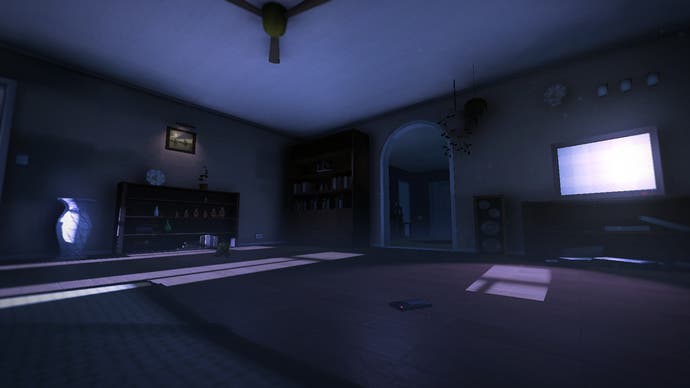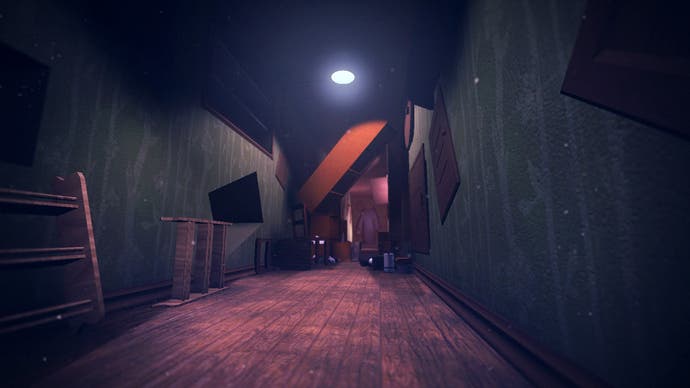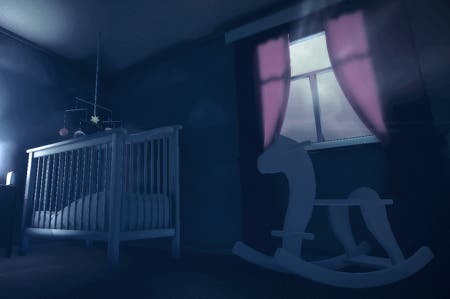Among The Sleep Preview: They Mostly Come At Night
Child's play.
If you've not heard of Among The Sleep, the unusually named brainchild of a group of Norwegian post grads, you're probably not alone. But after nearly half a million views, this startling gameplay demo has the indie scene buzzing. Its depiction of a first-person horror told through the eyes and stumbling little legs of a two-year old is as intriguing as anything I've seen all year, and reminiscent of a time when games actively sought out new ways to play and new stories to tell.
Adrian Tingstad Husby, the remarkably passionate and articulate in-house PR man (although spokesperson would be a better title) for Among The Sleep's developers, Krillbite, explains where the idea for such an unusual character and concept came from.
"We were all studying various aspects of experience production and interactive media at the College University of Hedmark, Norway, when we decided to start collaborating on a bigger project. So Among the Sleep actually started out as the bachelor thesis of most of the people currently in the studio. Then fast forward a year, to about the time we graduated last summer and applied for funding at the Norwegian Film Institute. To our delight we got our application approved"

"Our game designer isn't sure what exactly triggered the very first idea, but he has said that it popped into his mind one night about four years ago. It was the vision of a child fleeing from a monster in his room, running down the stairs and then hiding underneath, watching the monster's feet through the steps as it came walking slowly down the stairs in search for him - all seen from a first person perspective."
It's stirring stuff. While still in the relative early stages of development, Among The Sleep already ticks similar boxes to the horrifying Amnesia Dark Descent and the disconnecting unease of Penumbra - independent PC horror games designed to scare and unsettle rather than titillate or test dexterity. In an industry that's increasingly uninterested in the purity of horror, the indie space is marching ahead of big-budget studios when it comes to toying with our fears and insecurities.
"Among the Sleep is fuelled by a desire to innovate," Husby explains. "We think the medium is in grave need of more diversity, and we would love to contribute towards that. Also, we want to tell a compelling story both through an interesting storyline and metaphorically - related to what evokes this fear and confusion in the child. So we are consulting people with both practical and academic competence on the field of children's development and psychology, which we think is pretty unique.
"The teaser we published is captured in-game, and really depicts how some of the gameplay will work. In addition to the atmosphere shown in this video, we are also experimenting a lot with physical interaction with the environment. So for instance, one might have to make a staircase out of drawers, or push, pull and climb a chair to reach specific places. This is also part of our core immersion goal, in that we really want the player to feel like a part of the world. Apart from the physical interaction, we are working a lot with nailing the setting and atmosphere. In subtle and scary games, mentally preparing to enter the next room can constitute an interesting obstacle as well."

It's that final sentence that perhaps best sums up horror as a videogame genre. The palpable sense of dread that accompanies every creaking door in Silent Hill is far more upsetting than anything that could lie within (unless it's one of those two-headed baby face things from Silent Hill 3). With the conceit that our own imaginations are far more powerful a tool for fear than anything else, what better choice as 'hero' than a small child, whose entire existence is fuelled by the possibility and wonder their active minds imprint on the world they see?
With such a unique central character, it's not surprising that Krillbite mulled over the use of a third-person perspective, but its considered use of first-person already appears crucial to the experience. The way the camera wobbles and sways lends the action a tangible physicality, especially when coupled with the sweaty padded footsteps and panicked little breaths of our romper-suited champion.
"We actually gave a third person camera a try once, for the fun of it, and it certainly gave a whole other experience, just not the one we were looking for," Husby says.
"One of the most important aspects of Among the Sleep is immersion, which is naturally made difficult by the protagonist being a toddler and the target audience being adults. It's important that our players really feel like they are the child, and not that they are merely observing some other child. To us, third person seems like one of the traps that would ruin this.
"And actually, we've found that it is much easier than we first imagined getting adults to relate to a two-year-old. While many of us live "dull" adult lives without much action, there are at least two times in everyone's lives, regardless of background, when we all can relate to being authentically scared. And that's while we are dreaming and when we were children. Among the Sleep combines the two."

As the lost-in-translation title suggests, the action takes place when the toddler's family is happily in the land of nod, leaving our miniature hero free to explore a strange and spine-chilling world on his own. Whether the ensuring terror is real or imagined is unknown, but concept art suggests that later sections won't shy away from the surreal, suggesting our hero could be dreaming. One striking picture of the boy with his teddy (who is upright and walking) conjures up images of Lewis Carroll, while the shadowy beasties that flash past the window are straight out of the darker side of The Brothers Grimm.
It's Husby and his cohorts at Krillbite's commitment to artistry that's perhaps the most inspiring thing about Among The Sleep, though. A proof-of-concept video, even one as exciting as this, is obviously no guarantee of quality or even functionality, but hearing him speak about the industry (in his second language, no less) is very promising. An impassioned post on the studio's own blog reads like a manifesto for the team's intent.
"There is definitely an intrinsic conservatism to big business that makes the industry evolve a bit slower than what I'd prefer" Husby tells us. "One should design a vision and not a hit, which might not seem like a very business-friendly conclusion. But on the contrary, I also think there are huge economic arguments favouring this approach. For instance the industry should realize that despite the rise of casual and social games, many (if not most) game enthusiasts are still locked up in their niche where it's warm and safe.
"There could and should be millions upon millions more people who play and buy games! The problem is that the games industry is reluctant to expand into the waters where these people swim. And when something like Journey becomes the fastest and best selling title on PSN ever, it demonstrates how there is both an audience and demand for a wider diversity in games today.

"I think there are economic arguments for a greater variety in games already, so there can be both economic and artistic goals for evolving our medium. The indie scene is certainly at the fruitful frontier though, and often inspires big business in the process. But real innovation is hard, and pioneers often suffer much uncertainty and criticism. Then again, if a video game is easy to make, it's probably not worth doing."
Presumably, then, Among The Sleep is quite the undertaking for the fledgling team, and from a purely aesthetic point of view, their game could easily be mistaken for a big-budget release - the Unity engine is a malleable and powerful beast. A grant from the Norwegian Film Institute has given them the flexibility and freedom to create without publisher restraints, though, which could well prove vital for the game's ultimate success, both commercially and artistically.
"I think the interactive nature of video games has the potential to evoke stronger emotions than traditional media, not only regarding fear, but all emotions, Husby enthuses. "Why shouldn't it? It's the first medium that can fully reflect the interactivity of our very lives, and has a potential to really address the human mind.
"And what will we do with it?
"Future civilizations will look to our culture as a way of deciphering who we were, what was important to us, and what problems we faced. Then they'll find 600 versions of Call of Duty and Angry Birds and be like "What the f*** happened?"
Presumably not if they stumble across Among The Sleep. While not out until 2013, Krillbite's work is still another stirring indictment of an indie PC scene that's proving a fountain of creativity and progression in an industry that seems intent on eating itself. You won't want to sleep on this one.







